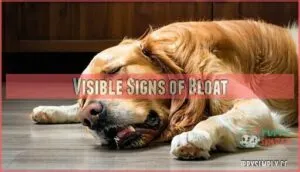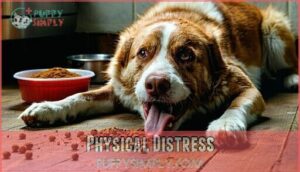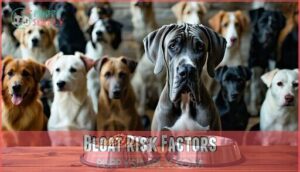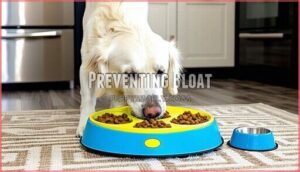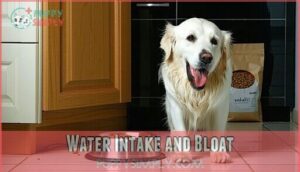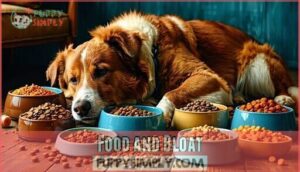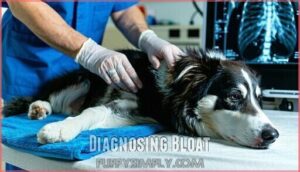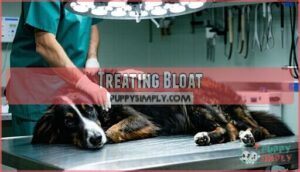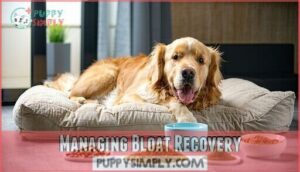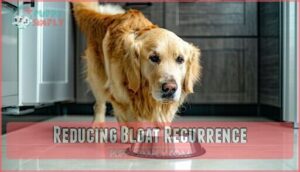This site is supported by our readers. We may earn a commission, at no cost to you, if you purchase through links.
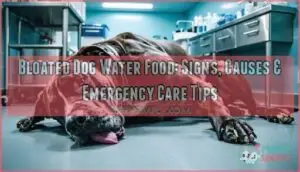
Your dog’s stomach can twist when filled with excessive food, water, or swallowed air, creating what vets call gastric dilatation-volvulus (GDV).
Watch for a distended belly, restlessness, unproductive retching, and rapid breathing – these aren’t just discomfort signals, they’re red flags demanding immediate action.
Large, deep-chested breeds face higher risks, especially when they gulp meals or guzzle water after exercise.
Prevention beats treatment every time: slow feeders, portion control, and timing meals away from vigorous activity can save your dog’s life.
Understanding the subtle warning signs and emergency protocols could mean the difference between a close call and tragedy.
Table Of Contents
- Key Takeaways
- Dog Bloat Symptoms
- Causes of Bloat
- Bloat Risk Factors
- Preventing Bloat
- Water Intake and Bloat
- Food and Bloat
- Diagnosing Bloat
- Treating Bloat
- Managing Bloat Recovery
- Reducing Bloat Recurrence
- Frequently Asked Questions (FAQs)
- Should a dog with bloat drink water?
- Does wet dog food help with bloat?
- Can dogs with bloat still drink water safely?
- How long after eating should dogs wait before drinking?
- Does the temperature of water affect bloat risk?
- Can ice water cause bloat in dogs?
- Should I limit water during hot weather despite bloat?
- Conclusion
Key Takeaways
- Recognize bloat symptoms immediately – You’ll spot a distended, hard belly, restless pacing, unproductive retching, and pale gums that signal this life-threatening emergency requiring instant veterinary care.
- Control your dog’s eating habits – You should feed smaller, frequent meals using slow feeders, avoid raised bowls, and wait 60 minutes after eating before allowing exercise or heavy water consumption.
- Monitor water intake carefully – You can’t restrict water access, but you should watch for excessive gulping, especially after meals, as rapid water consumption combined with food can trigger dangerous stomach expansion.
- Know your dog’s risk factors – You’re dealing with higher bloat risks if you own deep-chested breeds like Great Danes, dogs over 99 pounds, or pets with family histories of gastric dilatation-volvulus.
Dog Bloat Symptoms
Recognizing bloat symptoms quickly can save your dog’s life, as this life-threatening condition progresses rapidly without warning.
You’ll need to watch for specific physical and behavioral changes that signal your pet needs immediate veterinary attention.
Visible Signs of Bloat
You’ll spot a distended, hard swollen belly that looks unnaturally round.
You’ll catch your dog’s bloated stomach when it feels rock-hard and unnaturally swollen.
Your dog’s gum color may turn pale or white, signaling poor circulation. Watch for excessive drooling signs and repeated retching attempts without producing vomit.
Dogs with bloated stomach often adopt unusual posture changes, standing with their back arched or hunched.
These visual cues of dog bloating require immediate veterinary attention. Noticeable lethargy and irritability, which are signs of a sick dog, should also prompt a vet visit to address potential health issues.
Behavioral Changes
Restlessness becomes your dog’s silent alarm system when bloat strikes.
When your dog can’t find comfort anywhere, their restless pacing signals danger lurking within.
You’ll notice dramatic shifts in their usual calm demeanor as discomfort intensifies.
Watch for these key behavioral changes:
- Pacing – Your dog can’t settle, moving constantly around the house
- Restlessness – Unable to find comfortable positions, frequently changing spots
- Drooling – Excessive saliva production beyond normal amounts
- Whining – Vocal expressions of distress and dog discomfort
- Hiding – Seeking isolation in unusual places when pain overwhelms
These dog symptoms often appear before visible swelling, making behavioral observation essential for early detection.
Physical Distress
Physical distress manifests through unmistakable warning signs that demand immediate attention.
Your dog’s breathing difficulty and abdominal pain create a perfect storm of discomfort.
Watch for pale gums, weak pulse, and collapse risk as the bloated stomach restricts blood flow.
Retching without results, combined with pacing and swollen belly, signals your pet’s body is fighting a losing battle against this life-threatening condition.
Causes of Bloat
Understanding what causes bloat in your dog can help you recognize warning signs before they become life-threatening.
While genetics play a role, your dog’s eating habits and environment create the perfect storm for this dangerous condition.
Genetic Predispositions
Your dog’s family history plays a vital role in bloat risk. Certain breed predispositions stem from genetic factors that affect gastric emptying and muscle weakness.
Dogs with gene markers for slower stomach function face higher risks as they age. Breed inheritance patterns show Great Danes, German Shepherds, and other deep-chested breeds carry these risk factors through generations.
Mixed breed dogs, however, often benefit from increased genetic diversity, which can reduce the risk of inheriting such conditions.
Environmental Factors
While genetics play a significant role, environmental factors can trigger bloat episodes in susceptible dogs.
Climate changes affect digestion, with cold weather slowing gastric emptying and heat stress causing dehydration. Toxin exposure impairs gastric function, while stress levels from routine changes increase bloat risk.
Key environmental triggers include:
- Seasonal Bloat patterns – extreme temperatures disrupting normal digestive processes
- Living Conditions stress – anxiety from environmental changes affecting gastric motility
- Climate Impact on water intake – dehydration or excessive consumption altering food consumption patterns
Managing your dog’s environment reduces dietary factors that contribute to bloating episodes.
Bloat Risk Factors
Understanding your dog’s risk factors can help you recognize bloat before it becomes life-threatening.
Certain breeds, sizes, and individual characteristics make some dogs more vulnerable to this emergency condition than others, which is why recognizing these factors is crucial for emergency situations.
Breed Specific Risks
Why do certain breeds face dramatically higher bloat risks?
Deep-chested breeds like Great Danes carry a lifetime GDV risk exceeding 40%, while breed anatomy creates up to 20 times higher odds.
Family history doubles your dog’s susceptibility—genetic predisposition runs strong in large breeds.
Giant breed risks increase with chest depth-to-width ratios above 1.5, making breed susceptibility a vital factor.
Size and Weight Risks
Beyond breed considerations, your dog’s size and weight substantially impact dog bloat risk factors.
Larger dogs face higher risks due to their anatomy and eating habits.
Key size and weight risks include:
- Dogs over 99 pounds – substantially increased bloat susceptibility
- Rapid growth periods – especially in giant breeds during puppyhood
- Poor body condition – both overweight and underweight dogs show elevated risk
- Loss of muscle mass – older dogs with weakened abdominal muscles
- Improper portion control – leading to overeating and stomach distension
Maintaining your dog’s ideal weight through proper weight management helps reduce these risk factors in deep-chested breeds.
Preventing Bloat
You can’t prevent bloat entirely, but smart feeding habits substantially reduce your dog’s risk. The key is controlling how, when, and what your dog eats and drinks throughout the day.
Controlled Eating
Managing your dog’s eating habits can substantially reduce bloat risk.
Feed smaller, more frequent meals throughout the day rather than one large portion.
Slow feeder bowls and puzzle toys naturally encourage slower consumption, preventing rapid stomach filling.
Scheduled feeding times help regulate digestion and prevent overeating binges that contribute to dangerous gastric distension.
Consider also using technology, like smart feeding solutions, to help manage your pet’s food intake and prevent overeating binges that contribute to gastric distension.
Avoiding Raised Bowls
Research shows elevated food bowls may actually increase bloat risk in dogs.
Bowl Height Research indicates that raised feeding positions can promote faster eating and air swallowing, particularly problematic for deep-chested breeds prone to gastric dilatation-volvulus GDV.
Your veterinarian’s recommendations should guide individual dog needs, as some medical conditions require elevated bowls despite bloat concerns.
Exercise and Meal Timing
Beyond using proper bowls, your dog’s Post-meal Activity timing matters substantially for preventing bloat.
Wait sixty minutes after feeding before allowing Exercise Intensity activities like running or playing.
This Digestion Timing protects your pet’s stomach from dangerous twisting.
Establish a consistent Mealtime Routine with Activity Restrictions built in.
Consider slow feeder bowls to naturally pace dog bloat food intake and reduce gulping behaviors.
Water Intake and Bloat
You’ll need to carefully manage your dog’s water intake since drinking large amounts quickly can trigger bloat, especially when combined with dry food that expands in the stomach.
While constant access to fresh water prevents dangerous dehydration, monitoring how much and how fast your dog drinks helps reduce the risk of gastric dilatation-volvulus.
Safe Water Consumption
Water quality and hydration timing play pivotal roles in preventing bloat. You’ll want to provide fresh, clean water at room temperature while monitoring your dog’s intake patterns.
It’s important to note that activity levels affect hydration, requiring adjustments to water access.
To maintain proper hydration, follow these guidelines:
- Maintain bowl hygiene by washing water dishes daily with hot, soapy water
- Monitor water temperature – avoid ice-cold water that may cause rapid consumption
- Guarantee electrolyte balance through consistent, measured water access
- Track dog water intake to identify unusual drinking patterns early
- Limit water consumption immediately before and after meals to reduce bloat risk
Risks of Excessive Water
Excessive water consumption can trigger dangerous complications beyond simple stomach expansion.
When your dog drinks too much water too quickly, water intoxication and electrolyte imbalance become real threats. This kidney overload creates dilution hyponatremia, where sodium levels drop dangerously low.
A dog water fountain can help regulate intake.
Water retention worsens bloat symptoms, making safe hydration practices absolutely essential for your pet’s wellbeing.
Monitoring Water Intake
Someone’s always watching when your dog drinks—and that someone should be you.
Tracking your dog’s water intake helps identify early warning signs of bloat or other health issues.
- Water Monitoring Tools: Use measuring cups or smart water bowls to track daily consumption
- Dehydration Symptoms: Watch for excessive panting, dry gums, or lethargy indicating poor hydration strategies
- Intake Frequency: Monitor polydipsia patterns and excessive water consumption timing around meals
Consider using a smart feeding solution to help automate this process.
Food and Bloat
Your dog’s diet plays a vital role in preventing bloat, with certain foods and feeding practices substantially increasing or decreasing risk.
Understanding which foods to choose and how to feed them can help protect your dog from this life-threatening condition.
Safe Food Options
Quality dog food with digestible ingredients like chicken, turkey, and fish reduces bloat risk substantially.
Choose low-fat options under 20% fat content to prevent delayed gastric emptying. Maintain proper portion control through scheduled feeding times for ideal nutritional balance.
Consider your dog’s food allergies when selecting appropriate dog diet options. Well-balanced canine nutrition supports healthy dog digestive function effectively.
Many owners seek easily digestible options for their pets.
Foods to Avoid
Avoid high-fat dog food with fat listed in the first four ingredients – it increases bloat risk by 2.6 times.
Skip citric acid-containing kibble, especially if moistened. Fermentable ingredients like yeast dough create dangerous gas buildup.
Oily foods, processed meals, and fatty table scraps trigger both bloat and pancreatitis.
Food allergies from certain ingredients worsen digestive distress in your dog’s bloat-prone diet. Food bloat can occur if a dog consumes excessively large amounts of food rapidly.
Feeding Strategies
Through strategic meal frequency and portion control, you’ll transform your dog’s eating habits from risky to safe.
Feed smaller meals twice daily rather than one large portion, preventing stomach overload.
Choose appropriate food type and incorporate slow feeders to encourage mindful eating.
Monitor water intake carefully, ensuring your dog doesn’t gulp excessive amounts after meals.
These dog feeding practices substantially reduce bloat risk and promote overall health by encouraging mindful eating habits.
Diagnosing Bloat
When your dog shows bloat symptoms, quick and accurate diagnosis can save their life.
Your vet will perform a physical exam and may use X-rays to confirm if the stomach has twisted, determining the severity and best treatment approach.
Physical Examination
Your veterinarian’s skilled hands can detect critical signs during abdominal palpation, checking for a distended, rigid bloated abdomen while monitoring your dog’s heart rate and hydration status.
They’ll examine gum color for pale gums, assess muscle tone, and watch for concerning behaviors like pacing and retching that indicate your pup needs immediate attention.
- Abdominal palpation reveals stomach distension and rigidity that shouldn’t be ignored
- Gum color assessment identifies pale gums indicating poor circulation and shock
- Vital sign monitoring tracks heart rate and hydration status for emergency priorities
Diagnostic Tests
When your bloated dog arrives at the vet, X-ray imaging becomes the gold standard for dog bloat diagnosis.
Abdominal radiographs detect gastric torsion with over 90% accuracy, while blood analysis reveals electrolyte imbalances in half of affected dogs.
Veterinary diagnostics may include pressure measurement and endoscopy use to assess stomach wall integrity and guide treatment decisions effectively.
If your dog is also vomiting, be sure to note any fresh blood present in the sample.
Veterinary Evaluation
Your veterinary consultation begins with an Initial Assessment where professionals evaluate your dog’s condition through systematic examination.
During this critical Triage Urgency phase, veterinarians determine surgical candidacy based on clinical findings and assess appropriate Decompression Methods.
Through specialized veterinary diagnostics, they’ll evaluate Prognosis Factors to guide veterinary treatment decisions.
This thorough veterinary medicine approach guarantees your dog receives targeted veterinary advice for superior outcomes.
Treating Bloat
When your dog shows signs of bloat, you’re facing a life-threatening emergency that requires immediate veterinary intervention.
The treatment process involves rapid stabilization, stomach decompression, and often surgical correction to save your dog’s life.
Emergency Care
Time’s your enemy when bloat strikes your dog.
You’ll need immediate action to save their life.
Rush to the nearest emergency vet while calling ahead about gastric dilatation-volvulus GDV.
Don’t attempt home remedies for bloated dog symptoms.
Professional veterinary transport guarantees proper positioning during the critical journey.
Emergency care focuses on decompression methods and torsion assessment before post-op risks develop.
Stabilization Techniques
Once emergency care begins, your dog’s survival depends on immediate stabilization techniques that address the body’s cascading complications.
Veterinarians prioritize three critical interventions to restore your pet’s failing systems:
- Fluid therapy – IV electrolyte solution combats dehydration and restores fluid balance
- Decompression methods – Stomach tubes or needles release trapped gas pressure
- Monitoring essentials – Continuous assessment of heart rate, blood pressure, and breathing patterns
These stabilization techniques prepare your dog for potential torsion correction and surgical intervention ahead.
Surgical Options
When your dog’s stomach twisting escalates beyond decompression, surgical intervention becomes essential.
Gastropexy Types include open and laparoscopic surgery, with the latter offering faster Recovery Timeline.
Surgery addresses gastric dilatation-volvulus GDV through stomach decompression and gastropexy to prevent future stomach twisting.
Post-Surgery Care requires intensive monitoring, while Complication Risks include infection and recurrence without proper surgical anchoring.
Managing Bloat Recovery
Once your dog survives bloat, the recovery phase requires careful management to prevent complications and recurrence.
You’ll need to monitor your pet closely while making specific dietary adjustments that support healing and reduce future risk.
Post-Treatment Care
After successful treatment, your dog’s recovery depends on careful monitoring and structured care.
Post-treatment care involves managing pain, preventing complications, and supporting proper healing through controlled rest and gradual activity resumption.
Critical recovery priorities:
- Dietary Adjustments – Small, frequent meals prevent stomach re-expansion and support healing
- Medication Management – Pain relief and antibiotics require strict adherence to prevent setbacks
- Activity Restriction – Limited movement for 10-14 days protects surgical sites and prevents re-injury
- Wound Care – Daily inspection of incisions confirms proper healing and early infection detection
Dietary Changes
Several critical dietary changes support your dog’s recovery after bloat treatment.
You’ll need to implement portion control with smaller, frequent meals and carefully monitor food texture shifts. Your veterinarian will recommend specific ingredient quality standards and may suggest supplement use to aid digestion.
| Dietary Change | Implementation | Timeline |
|---|---|---|
| Feeding Schedule | 3-4 small meals daily | Immediate post-surgery |
| Bland Diet | Rice, boiled chicken, pumpkin | First 7-14 days |
| Food Intolerances | Eliminate gas-producing foods | Ongoing assessment |
| Dog Bloat Diet | High-quality, easily digestible kibble | 2-4 weeks shift |
| Dog Diet Adjustments | Monitor for digestive upset | Continuous monitoring |
Ongoing Monitoring
Since recovery requires careful attention to your dog’s wellbeing, establishing a systematic monitoring routine helps detect potential complications early.
Regular checkups with your veterinarian guarantee proper healing, while vigilance at home protects against recurrence.
- Behavior observation – Watch for restlessness, pacing, or discomfort
- Weight tracking – Monitor gradual weight changes weekly
- Dog water intake – Track daily consumption patterns
- Dietary adjustments – Note appetite changes or food preferences
- Dog bloating symptoms – Check for abdominal distension or retching
Reducing Bloat Recurrence
After your dog recovers from bloat, you’ll need to make permanent changes to prevent this life-threatening condition from returning.
Long-term success depends on consistent dietary modifications, lifestyle adjustments, and regular veterinary monitoring to catch early warning signs.
Lifestyle Changes
After recovery care, implementing specific lifestyle changes helps protect your dog from future bloat episodes.
Consider these modifications that target key risk factors while maintaining your pet’s quality of life.
| Activity Management | Environment Control | Health Monitoring |
|---|---|---|
| Limit post-meal exercise for 60-90 minutes | Remove elevated food bowls unless medically required | Schedule regular checkups every 6 months |
| Use slow feeder bowls to control eating pace | Secure food storage to prevent overeating | Monitor water intake throughout the day |
| Provide mental stimulation through puzzle toys | Create calm feeding environments | Watch for stress reduction signs during meals |
| Encourage gentle social interaction after meals | Maintain consistent feeding practices | Support dental health with appropriate chews |
These changes work together to minimize bloat triggers while supporting your dog’s overall well-being and dog bloat prevention strategies.
Dietary Modifications
After implementing lifestyle changes, you’ll need to adjust your dog’s diet to prevent future bloat episodes.
Focus on Meal Frequency by offering smaller portions three to four times daily rather than one large meal.
Choose high-quality pet food with consistent Food Consistency and superior Ingredient Quality to support proper digestion.
Practice strict Portion Control and consider Supplement Use under veterinary guidance to optimize your dog’s pet nutrition and reduce dog bloat dietary factors through proven dog feeding techniques.
Ongoing Veterinary Care
Throughout your dog’s recovery journey, establishing a partnership with your veterinarian becomes essential for long-term success.
Schedule regular follow-up exams to monitor for complications and adjust lifestyle modifications as needed.
Your vet will guide medication management protocols and provide emotional support during this challenging time.
Ongoing veterinary care guarantees proper dog bloat management, helping prevent future pet emergency situations through proactive monitoring and treatment adjustments.
Frequently Asked Questions (FAQs)
Should a dog with bloat drink water?
When in doubt, seek help" – this ancient wisdom applies perfectly to bloat emergencies.
No, don’t give water to a bloated dog.
The distended stomach can’t process fluids properly, and drinking may worsen the dangerous gas buildup.
Rush to your vet immediately instead.
Does wet dog food help with bloat?
Wet dog food can help reduce bloat risk compared to dry kibble since it doesn’t expand dramatically in your dog’s stomach when mixed with water or saliva.
Creating less pressure buildup.
Can dogs with bloat still drink water safely?
Dogs with bloat shouldn’t drink water freely – it can worsen stomach distension and increase pressure.
You’ll need to restrict water access immediately and get emergency veterinary care, as bloat requires urgent medical intervention.
How long after eating should dogs wait before drinking?
Allow your dog 30-60 minutes after eating before drinking large amounts of water.
This waiting period helps prevent rapid stomach expansion that can contribute to dangerous bloat, especially in deep-chested breeds.
Does the temperature of water affect bloat risk?
Water temperature doesn’t directly increase bloat risk in dogs.
However, you should avoid giving your dog ice-cold water immediately after eating, as rapid temperature changes can cause stomach discomfort and potentially slow digestion.
Can ice water cause bloat in dogs?
Ice water doesn’t directly cause bloat in dogs.
However, drinking large amounts of cold water rapidly can contribute to gastric dilatation, especially when combined with other risk factors like eating too quickly or exercising after meals.
Should I limit water during hot weather despite bloat?
Don’t restrict water access during hot weather – dehydration poses greater immediate risks than bloat.
Provide fresh water freely, but monitor drinking habits and consider offering smaller, frequent amounts if you’re concerned about rapid consumption, as this can help mitigate the risk of dehydration.
Conclusion
Knowledge becomes your shield against bloated dog water food emergencies that strike without warning.
You’ve learned to recognize the critical signs, understand breed-specific risks, and implement prevention strategies that protect your companion.
Quick action during bloat episodes can save your dog’s life, while proper feeding schedules and controlled water intake reduce future risks.
Trust your instincts when something seems wrong, and never hesitate to contact your veterinarian immediately if you suspect gastric dilatation-volvulus.
- https://www.webmd.com/pets/dogs/gastric-volvulus-bloat-dogs
- https://www.petinsurance.com/healthzone/pet-health/health-conditions/stomach-bloat-life-threatening-to-dogs/
- https://breedingbetterdogs.com/article/bloat-and-risk-factors
- https://www.research.ed.ac.uk/files/59772063/57_599_1_PB.pdf
- https://gsvs.org/blog/dog-bloated-stomach-home-remedy-urgent-warning/

